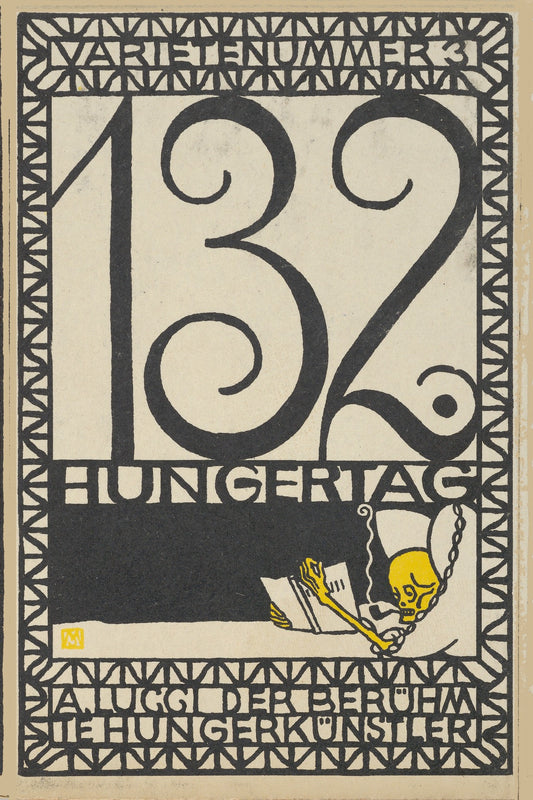-
Variety Act 10 - Man or Reptile or Razor (Varietenummer 10 Mensch oder Reptil oder Rasiermesser) by Moriz Jung, 1907 - Postcard
Regular price £1.99 GBPRegular priceUnit price / per -
Variety Act 3 - 132nd Day of Fasting, A. Lucci the Famous Hunger Artist (Varietenummer 3- 132 Hungertag, A. Lucci der Berühmte Hungerkünstler) by Moriz Jung, 1907 - Postcard
Regular price £1.99 GBPRegular priceUnit price / per -
The Chess Players (Wiener Café- Die Schachspieler) by Moriz Jung Austrian, 1911 - Postcard
Regular price £1.99 GBPRegular priceUnit price / per -
Vaudeville Act 6 - Zoltan Toeroek, Child Prodigy (Varieténummer 6- Zoltan Toeroek, Das Wünderkind) by Moriz Jung, 1907 - Postcard
Regular price £1.99 GBPRegular priceUnit price / per -
Dancers (Apachentänze!) by Moriz Jung, 1911 - Postcard
Regular price £1.99 GBPRegular priceUnit price / per -
Conversation Between Mutes (Gespraech zwischen Stummen) by Moriz Jung - 1907
Regular price From £14.00 GBPRegular priceUnit price / per -
Gespräch eines Redakheurs mit einem Staatsmann (Editor's Conversation with a Statesman) by Moriz Jung -1907
Regular price From £14.00 GBPRegular priceUnit price / per -
Dancers (Apachentänze!) by Moriz Jung - 1911
Regular price From £14.00 GBPRegular priceUnit price / per -
Nightly Conversations (Naechtliches Gespraech) by Moriz Jung - 1907
Regular price From £14.00 GBPRegular priceUnit price / per -
At the Heuriger (Beim Heurigen) by Moriz Jung - 1911
Regular price From £14.00 GBPRegular priceUnit price / per -
Naturally Gifted Singer (Natursänger!) by Moriz Jung - 1911
Regular price From £14.00 GBPRegular priceUnit price / per -
In the Little Café (Wiener Café- Im Tschecherl) by Moriz Jung - 1911
Regular price From £14.00 GBPRegular priceUnit price / per -
Viennese Café On the Terrace (Wiener Café- Auf der Terasse) by Moriz Jung - 1911
Regular price From £14.00 GBPRegular priceUnit price / per -
The Chess Players (Wiener Café- Die Schachspieler) by Moriz Jung Austrian - 1911
Regular price From £14.00 GBPRegular priceUnit price / per -
Carambole (Wiener Café- Carabol) by Moriz Jung - 1911
Regular price From £14.00 GBPRegular priceUnit price / per -
Vaudeville Act 6 - Zoltan Toeroek, Child Prodigy (Varieténummer 6- Zoltan Toeroek, Das Wünderkind) by Moriz Jung - 1907
Regular price From £14.00 GBPRegular priceUnit price / per
Collection: Moriz Jung
Moriz Jung (1885-1915) prints, artworks, cards and postcards.
Jung was born in Nikolsburg (now Mikulov), Czech Republic. From 1901 to 1908 he attended the Kunstgewerbeschule in Vienna, where he was taught by Alfred Roller, Carl Otto Czeschka and Bertold Löffler. He showed talent as an illustrator in woodcuts, linocuts, lithographs and book images and became a member of the Wiener Werkstätte. During his studies he published a book of coloured woodcuts, Freunden geschnitten und gedruckt von Moriz Jung (Leipzig and Vienna, 1906), an alphabetical primer in the form of animal pictures, and in 1907 he designed a Poster for the Cabaret Fledermaus for the Wiener Werkstätte. He died in battle in World War I in the Carpathian mountains in East Gallicia. - The Vienna Secession on Moriz Jung prints and artworks
Jung's series on flight, printed in 1911, is among his most memorable. The six satirical prints poke fun at early aviation. Though Jung was not the first artist to treat this subject matter, his images are bright and playful, and they hint at the somewhat dark Viennese sense of humor (a characteristic highlighted by other Wiener Werkstätte postcards as well).
Jung's planes are based on real aircraft of the time. Tête à Tête on the 968th Floor of a Skyscraper is a reference to the French pilot M. Blériot, who made the first flight in an aircraft across the English Channel in 1909. The construction of the plane in this print and in Bloodless Giraffe Hunt looks similar to Blériot's plane as depicted in a trading card published by the Philadelphia Caramel Company (1910). The wings of the planes in the Aeroplegasus (Anzani Angines) and The Duke of Gramatneiss's Famous Pack of Birds look more like those of birds than in the other prints. For Aeroplegasus, this makes sense, as his mechanized flying horse is entirely fanciful...
The Wiener Werkstätte postcards were meant to be shared, traded, and discussed. The fact that Moriz Jung anticipated that a large audience would find his satirical postcards of early flight amusing indicates that there must have been an enthusiastic and good-humored attitude (tinged with some skepticism) toward the new technology of flight in pre-war Vienna.- The Met on Moriz Jung postcards
















